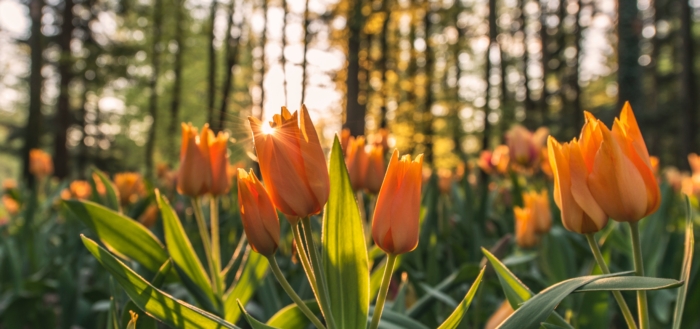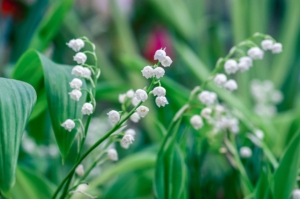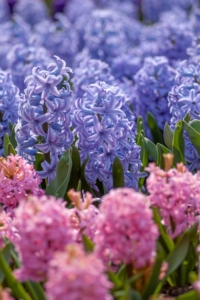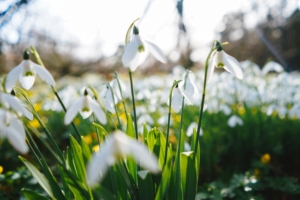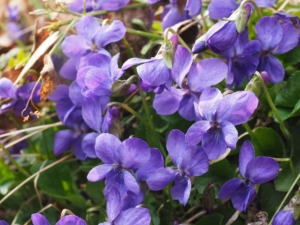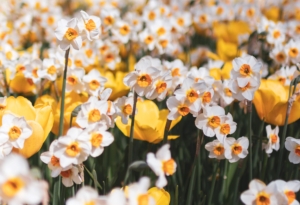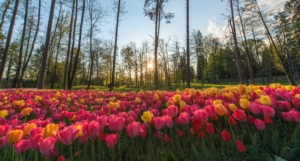Spring has officially arrived and it is undoubtedly a favourite season for many. Its serene beauty provides endless inspiration for artists, writers, and… parents. Whether one desires to make a painting, write a poem, or choose the perfect name for a spring baby, this season provides the perfect resources for creativity.
As the outdoors overflow with delightful colours, celebrating the revival of nature, we could not think of a better time for making a bouquet of botanical names. Here is our selection of flowers which inspired some outstanding spring names, especially for children born during this colourful season.
1. Lily
Lily has been on top of the charts since the late 19th century, being by far one of the most popular spring-inspired names. Besides being used as a diminutive form of the equally famous Elisabeth, Lily is also an independent given name, adopted by many cultures and highly present in literature, media, and the everyday life. However, for those in search of rarer terms, a distinctive name which carries the same meaning as Lily is Calla. Some interesting equivalents from other cultures include: Kielo (Finnish), Đurđica (Croatian), Azucena (Spanish), Crina (Romanian), and Nari (Korean).
2. Hyacinth
The blue fragrant flower inspired an exotic-sounding name with origins in the ancient times. Its roots travel back to Greek mythology, which tells the story of Hyacinthus, a Spartan hero linked to the birth of a bluebell-like flower. Later on, several saints carried the name Hyacinth. Initially a male name, it became exclusively female in the 19th century, and neutral nowadays. While Hyacinth gained visibility due to the novels written by Henry James, the Spanish variant of the name, Jacinta (with the masculine form Jacinto), has been often considered a softer and prettier alternative, especially in the English speaking countries.
Across Europe, there are several equivalents of this name: Hyazinth (m. German), Jácint (m. Hungarian), Jácinta (f. Hungarian), Hyacinthe (m. French), Giacinto (m. Italian), Giacinta (f. Italian), and Jacek (m. Polish).
3. Snowdrop
A name that exudes both fragility and courage, Snowdrop (f. English) has been used especially at the beginning of the 20th century. Now it is generally considered a rare name, which makes it even more special and unique. In other languages, there are several feminine given names which mean “snowdrop flower”; these include: Eirlys (Welsh), Hóvirág (Hungarian), Berfin (Kurdish), and Endzela (Georgian).
4. Violet
Derived from the Latin term viola, Violet (f. English) is essentially linked to the iconic purple spring flower. As many other great names, it has not been static in terms of popularity – once incredibly used, it fell out of favour during the last century, just to make a huge comeback nowadays. A factor which might have contributed to its fast climb to popularity can be traced in pop culture trends: a series of famous actors, such as Ben Affleck, chose to name their daughters Violet. Moreover, successful films and books for children portray characters carrying this name (e.g.: Charlie and the Chocolate Factory). In name statistics released annually by the governments, Violet is currently close to the top of the charts.
The floral-inspired name is highly present in other cultures as well. Some of its foreign variants include: Sumire (Japanese), Calfuray (Mapuche), Ibolya (Hungarian), Viola (Italian; diminutive Violetta), Violeta (Romanian), Wiola (Polish; variants Wioleta, Wioletta), and Sigal (Hebrew).
5. Daffodil
While the feminine English name Daffodil is rather uncommon, its neo-Latin equivalents are popular even nowadays, despite their longevity. With an origin that goes back to mythological stories, these names derive from Narkissos, the Latinized form of the Greek name Νάρκισσος. The ancient myths describe Narkissos, a handsome young man who stared at his own reflection for so long that he perished and was ultimately transformed into a daffodil. Several variants of his name can be found in neo-Latin cultures: Narciso (m. Italian, Spanish, Portuguese), Narcisa (f. Italian, Spanish, Portuguese, Romanian), Narcis (m. Romanian, Catalan), and Narcisse (n. French).
6. Iris
Centuries ago, the iris was considered a symbol of royalty and power; each of its petals represented valour, faith, and wisdom. The tall, gracious flower received its name from Iris, the goddess of the rainbow from ancient mythology.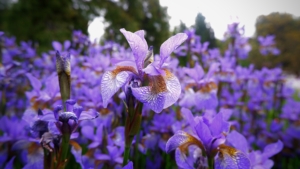 Originally Greek, the feminine name Iris is used in many cultures nowadays, especially English, German, Dutch, Swedish, Norwegian, Danish, Finnish, French, Spanish, and Italian. Similar to Violet, another name which passed the test of time, Iris managed to arrive close to the top of the charts, experiencing a sudden spike in popularity. Its revival might also be linked to mediatization, as famous popular culture figures, such as Jude Law, chose this name for their daughters. Foreign equivalents of Iris include: Eirys (Welsh), Elestren (Cornish), and Ayame (Japanese).
Originally Greek, the feminine name Iris is used in many cultures nowadays, especially English, German, Dutch, Swedish, Norwegian, Danish, Finnish, French, Spanish, and Italian. Similar to Violet, another name which passed the test of time, Iris managed to arrive close to the top of the charts, experiencing a sudden spike in popularity. Its revival might also be linked to mediatization, as famous popular culture figures, such as Jude Law, chose this name for their daughters. Foreign equivalents of Iris include: Eirys (Welsh), Elestren (Cornish), and Ayame (Japanese).
In English speaking countries, there are quite a few other spring flowers which have been adapted as feminine given names, such as: Azalea, Bluebell, Camellia, Dahlia, Magnolia, Poppy, Primrose, and Pansy. Rarely, one may encounter the names Freesia, Lilac, Marigold, Peony, Petunia, and Zinnia; while they are not commonly used, these unique names certainly help their possessors to stand out in a crowd.
The name Blossom (f. English) came into use in the 19th century and has been considered a rare name ever since. However, there are foreign alternatives which are much more popular in their home countries, such as:
- Smadar (f. Hebrew), meaning “to blossom”;
- Izdihar (f. Arabic), meaning “blossoming, prospering”;
- Florence (n. English, French), meaning “prosperous”;
- Thalia (f. Greek), meaning “to blossom”.
Additionally, given names which mean “flower” can be identified in almost every culture in the world. These are usually feminine and they include: Virág (Hungarian), Kukka (Finnish), Mali (Thai), Bluma (Yissish), Bopha (Khmer), Blejan (Cornish), Blodeuyn (Welsh), Nawra (Arabic), Sethunya (Tswana), Cvetka (Slovene), Cvijeta (Serbian), Cvita (Croatian), Hua (Chinese), and Hoa (Vietnamese).
Other spring-inspired names selected from around the globe include:
- Sakiko (f. Japanese), from saki (咲) meaning “blossom” and ko (子) meaning “child”;
- Haruka (f. Japanese), from haru (春) meaning “spring” and ka (花) meaning “flower”;
- Ayaka (f. Japanese), from aya (彩) meaning “colour” and ka (花) meaning “flower”;
- Bahargül (f. Turkmen), from bahar meaning “spring” and gül meaning “flower”;
- Anargul (f. Kazakh), meaning “blooming pomegranate tree”;
- Sakura (f. Japanese), meaning “cherry blossom”;
- Golbahar (f. Persian), meaning “spring rose”;
- April (f. English), from the Latin aperire meaning “to open” (referred to the opening of flowers); the French equivalent is Avril;
- Pranvera (f. Albanian), from pranverë meaning “spring, nearby summer”; the equivalent in Italian/Spanish is Primavera and in Hebrew Aviv;
- Eilir (n. Welsh), meaning “butterfly” and “spring”;
- Brândușa (f. Romanian), meaning “crocus”;
- Primula (m. Italian), meaning “primrose”;
- Lalka (f. Bulgarian), meaning “tulip”; the equivalent in Persian is Laleh and in Turkish Lale;
- Chloe (f. English), from Greek, meaning “green shoot” and referring to the growth of new plants during spring.
Ranging from unique to familiar and from exotic to common, spring-inspired names may suit every sensibility. While some of them have gained popularity recently, they are not what could be called overused, which makes them never go unnoticed. These names evoke both gracefulness and strength, as they remind us of the delicacy of early-blooming flowers and the regenerative power of spring.

